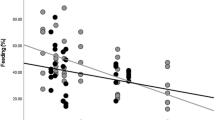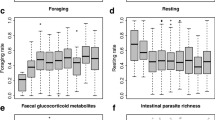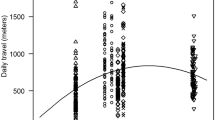Abstract
The ecological-constraints model assumes that food items occur in depletable patches and proposes that an increase in group size leads to increased day range due to more rapid patch depletion. Smaller groups become advantageous when an increase in travel costs is not repaid by an increase in energy gained or some other fitness advantage. On the other hand, we also know that group size can be influenced by social factors. Here we contrast the diet and group size of red colobus (Procolobus badius) and black-and-white colobus (Colobus guereza) in Kibale National Park, Uganda to consider how ecological and social factors are affecting their group sizes. Subsequently, we examine whether the insights gained from this detailed comparison can provide an understanding of why the social organization and group size of mantled howlers (Alouatta palliata) and black howlers (A. pigra) differ. Two groups of red colobus and two groups of black-and-white colobus were studied over 10 months. Red colobus groups were larger (48 and 24) than black-and-white colobus groups (9 and 6). The two groups of red colobus overlap home ranges with the two groups of black-and-white colobus; 75% and 95% of their home ranges were within red colobus’s home range. There was a great deal of similarity in the plant parts eaten by the two species and both species fed primarily on young leaves (red colobus 70%, black-and-white colobus 76%). In terms of the actual species consumed, again there was a great deal of similarity between species. The average dietary overlap among months for the two neighboring groups of red colobus was 37.3%, while the dietary overlap between the red colobus and the black-and-white colobus group that had its home range almost entirely within the home range of the red colobus groups averaged 43.2% among months. If ecological conditions were responsible for the difference in group size between the two colobine species, one would expect the density of food trees to be lower in the home ranges of the black-and-white colobus monkeys, since they have the smaller group size. We found the opposite to be true. Both black-and-white colobus groups had more food trees and the cumulative size of those trees was greater than those in the red colobus’s home ranges. We quantify how these differences parallel differences in mantled and black howlers. The average group size for mantled howlers was 12.9 individuals, and for black howlers it was 5.3 individuals. We explore possible social constraints, such as infanticide, that prevent black-and-white colobus and black howlers from living in large groups.

Similar content being viewed by others
References
Altmann SA (1959) Field observations on a howling monkey society. J Mamm 40:317–330
Baldwin JD, Baldwin JI (1972) Population density and use of space in howling monkeys (Alouatta villosa) in southwestern Panama. Primates 13:371–379
Baldwin JD, Baldwin JI (1976) Primate populations in Chiriqui, Panama. In: Thorington RW, Heltne PN (eds) Neotropical primates: field studies and conservation. National Academy of Sciences, Washington, D.C., pp 20–31
Baranga D (1982) Nutrient composition and food preferences of colobus monkeys in Kibale Forest, Uganda. Afr J Ecol 20:113–121
Bernstein IS (1964) A field study of the activities of howler monkeys. Anim Behav 12:92–97
Boesch C (1996) Social grouping of Tai chimpanzees. In: McGrew WC, Marchant LF, Nishida T (eds) Great ape societies. Cambridge University Press, Cambridge, pp 101–113
Boinski S, Treves A, Chapman CA (2000) A critical evaluation of the influence of predators on primates: effects of group movement. In: Boinski S, Garber P (eds) On the move: how and why animals travel in groups. University of Chicago Press, Chicago, pp 43–72
Bolin I (1981) Male parental behaviour in black howler monkeys (Alouatta palliata pigra) in Belize and Guatemala. Primates 22:349–360
Brockett RC, Horwich RH, Jones CB (1999) Disappearance of infants following male takeovers in the Belizean black howler monkey (Alouatta pigra). Neotrop Primates 7:86–88
Brown JK (1978) Weight and density of crowns of Rocky Mountain conifers. USDA For Ser Res Pap INT-129, Ogden
Carpenter CR (1934) A field study of the behaviour and social relations of howling monkeys. Comp Psychol Monogr 10:1–168
Carpenter CR (1962) Field studies of a primate population. In: Bliss EL (ed) Roots of behavior. Harper and Row, New York, pp 286–294
Catchpole WR, Wheeler J (1992) Estimating plant biomass: a review of techniques. Aust J Ecol 17:121–131
Chapman CA (1987) Flexibility in diets of three species of Costa Rican primates. Folia Primatol 49:90–105
Chapman CA (1990) Ecological constraints on group size in three species of neotropical primates. Folia Primatol 55:1–9
Chapman CA, Chapman LJ (1996) Mixed species primate groups in the Kibale forest: ecological constraints on association. Int J Primatol 17:31–50
Chapman CA, Chapman LJ (2000a) Determinants of group size in primates: the importance of travel costs. In: Boinski S, Garber P (eds) On the move: how and why animals travel in groups. University of Chicago Press, Chicago, pp 24–42
Chapman CA, Chapman LJ (2000b) Interdemic variation in mixed-species association patterns: common diurnal primates of Kibale National Park, Uganda. Behav Ecol Sociobiol 47:129–139
Chapman CA, Chapman LJ (2002) Foraging challenges of red colobus monkeys: influence of nutrients and secondary compounds. Comp Biochem Phys 133:861–875
Chapman CA, Lambert J (2000) Habitat alteration and the conservation of African primates: a case study of Kibale National Park, Uganda. Am J Primatol 50:169–185
Chapman CA, Chapman LJ, Wrangham RW, Hunt K, Gebo D, Gardner L (1992) Estimators of fruit abundance of tropical trees. Biotropica 24:527–531
Chapman CA, Wrangham RW, Chapman LJ (1995) Ecological constraints on group size: an analysis of spider monkey and chimpanzee subgroups. Behav Ecol Sociobiol 36:59–70
Chapman CA, Chapman LJ, Wrangham R, Isabirye-Basuta G, Ben-David K (1997) Spatial and temporal variability in the structure of a tropical forest. Afr J Ecol 35:287–302
Chapman LJ, Chapman CA, Brazeau D, McGlaughlin B, Jordan M (1999) Papyrus swamps and faunal diversification: geographical variation among populations of the African cyprinid Barbus neumayeri. J Fish Biol 54:310–327
Chapman CA, Chapman LJ, Bjorndal, KA, Onderdonk DA (2002) Application of protein to fiber ratios to predict colobine abundance on different spatial scales. Int J Primatol 3:283–310
Chivers DJ (1969) On the daily behaviour and spacing of howling monkey groups. Folia Primatol 10:48–102
Clarke MR, Zucker EL, Scott NJ (1986) Population trends of the mantled howler groups of La Pacifica, Guanacaste, Costa Rica. Am J Primatol 11:79–88
Cody ML (1971) Finch flocks in the Mojave desert. Theor Popul Biol 2:141–158
Coehlo AM, Coehlo LS, Bramblett CA, Bramblett SS, Quick LB (1976) Ecology, population characteristics and sympatric associations in primates: a bioenergetic analysis of howler and spider monkeys in Tikal. Yearb Phys Anthropol 20:96–135
Collias N, Southwick C (1952) A field study of population density and social organization in howling monkeys. Proc Am Philos Soc 96:143–156
Crockett CM, Janson CH (2000) Infanticide in red howlers: female group size, male membership, and possibly link to folivory. In: Schaik CP van, Janson CH (eds) Infanticide by males and its implications. Cambridge University Press, Cambridge, pp 75–98
Davies AG (1994) Colobine populations. In: Davies AG, Oates JF (eds) Colobine monkeys: their ecology, behaviour and evolution, Cambridge Press, Cambridge, pp 285–310
Dunbar RIM (1987) Habitat quality, population dynamics, and group composition in colobus monkeys (Colobus guereza). Int J Primatol 8:299–330
Estrada A (1982) Survey and census of howler monkeys (Alouatta palliata) in the rain forest of “Los Tuxtlas” Veracruz, Mexico. Am J Primatol 2:363–372
Estrada A, Mendoza A, Castellanos L, Pacheco R, Belle SV, Garcia V, Munoz D (2002a) Population of black howler monkey (Alouatta pigra) in a fragmented landscape in Palenque, Chiapas, Mexico. Am J Primatol 58:45–55
Estrada A, Castellanos L, Garcia Y, Franco B, Munoz D, Ibarra A, Rivera A, Fuentes E, Jimenez C (2002b) Survey of black howler monkey, Alouatta pigra, population at the Mayan site of Palenque, Chiapas, Mexico. Primates 43:51–58
Fedigan LM (1987) Demographic trends in the Alouatta palliata and Cebus capucinus populations of Santa Rosa National Park, Costa Rica. In: Else JG, Lee PC (eds) Primate ecology and conservation, Cambridge University Press, London, pp 285–293
Fedigan LM, Jack K (2001) Neotropical primates in a regenerating Costa Rican dry forest: comparisons of howler and capuchin population patterns. Int J Primatol 22:689–713
Fedigan LM, Fedigan L, Chapman CA (1985) A census of Alouatta palliata and Cebus capucinus monkeys in Santa Rosa National Park, Costa Rica. Brenesia 23:309–322
Fimbel C, Vedder A, Dierenfeld E, Mulindahabi F (2001) An ecological basis for large group size in Colobus angolensis in the Nyungwe Forest, Rwanda. Afr J Ecol 39:83–92
Fishkind AS, Sussman RW (1987) Preliminary survey of the primates of the Zona Protectora and La Selva Biological Station, northeast Costa Rica. Primate Conserv 8:63–66
Freese C (1976) Censusing Alouatta palliata and Cebus capucinus in Costa Rican dry forest. In: Thorington RW, Heltne PG (eds) Neotropical primates: field studies and conservation. National Academy of Sciences, Washington,D.C., pp 4–9
Ganzhorn JU (1992) Leaf chemistry and the biomass of folivorous primates in tropical forests. Oecologica 91:540–547
Gillespie TR, Chapman CA (2001) Determinants of group size in the red colobus monkey (Procolobus badius): an evaluation of the generality of the ecological constraints model. Behav Ecol Sociobiol 50:329–338
Gonzalez-Kirchner JP (1998) Group size and population density of the black howler monkey (Alouatta pigra) in Muchukux forest, Quintana Roo, Mexico. Folia Primatol 69:260–265
Hamilton WD (1971) Geometry of the selfish herd. J Theor Biol 31:295–311
Harrington GN (1979) Estimation of above-ground biomass of trees and shrubs. Aust J Bot 27:135–143
Heltne PG, Turner DC, Scott NJ (1976) Comparisons of census data on Alouatta palliata from Costa Rica and Panama. In: Thorington RW, Heltne PG (eds) Neotropical primates: field studies and conservation. National Academy of Sciences, Washington, D.C., pp 10–19
Holmes RT, Pitelka FA (1968) Food overlap among coexisting sandpipers on northern Alaskan tundra. Syst Zool 17:305–318
Horwich RH, Johnson ED (1986) Geographical distribution of the black howler (Alouatta pigra) in Central America. Primates 27:53–62
Horwich RH, Lyon J (1990) The Belizean rain forest: the community baboon sanctuary. Orang-Utan Press, Gay Mills, Wis.
Isbell LA (1991) Contest and scramble competition: patterns of female aggression and ranging behavior among primates. Behav Ecol 2:143–155
Janson CH (1988) Intra-specific food competition and primate social structure: a synthesis. Behaviour 105:1–17
Janson CH, Goldsmith ML (1995) Predicting group size in primates: foraging costs and predation risks. Behav Ecol 6:326–336
Janson CH, Schaik CP van (2000) The behavioral ecology of infanticide by males. In: Schaik CP van, Janson CH (eds) Infanticide by males and its implications. Cambridge University Press, Cambridge, pp 469–494
Maisels F, Gautier-Hion A, Gautier J-P (1994) Diets of two sympatric colobines in Zaire: more evidence on seed-eating in forests on poor soils. Int J Primatol 15:681–701
Milton K (1979) Factors influencing leaf choice by howler monkeys: a test of some hypotheses of food selection by generalist herbivores. Am Nat 114:363–378
Milton K (1982) Dietary quality and demographic regulation in a howler monkey population. In: Leigh EG, Rand AS, Windsor DM (eds) The ecology of a tropical forest. Smithsonian Institution Press, Washington, D.C., pp 273–289
Milton K (1984) Habitat, diet, and activity patterns of free-ranging woolly spider monkeys (Brachyteles arachnoides E. Geoffroyi 1806). Int J Primatol 5:491–514
Milton K (1998) Physiological ecology of howlers (Alouatta): energetic and digestive considerations and comparison with the Colobinae. Int J Primatol 19:513–547
Milton K, Mittermeier RA (1977) A brief survey of the primates of Coiba Island, Panama. Primates 18:931–936
Milton K, Soest PJ van, Robertson JB (1980) Digestive efficiencies of wild howler monkeys. Physiol Zool 53:402–409
Mittermeier RA (1973) Group activity and population dynamics of the howler monkey on Barro Colorado Island. Primates 14:1–19
Newton PN (1986) Infanticide in an undisturbed forest population of hanuman langurs. Presbytis entellus. Anim Behav 34:785–789
Noë R, Bshary R (1997) The formation of red colobus-diana monkey associations under predation pressure from chimpanzees. Proc R Soc Lond B 264:253–259
Oates JF (1974) The ecology and behaviour of the black-and-white colobus monkey (Colobus guereza Ruppell) in East Africa. PhD thesis, University of London
Oates JF (1977a) The guereza and its food. In: Clutton-Brock TH (ed) Primate ecology. Academic, London, pp 275–321
Oates JF (1977b) The social life of a black-and-white colobus monkey, Colobus guereza. Z Tierpsychol 45:1–60
Oates JF (1994) The natural history of African colobines. In: Davies AG, Oates JF (eds) Colobine monkeys: their ecology, behaviour and evolution. Cambridge University Press, Cambridge, pp 75–128
Oates JF, Whitesides GH, Davies AG, Waterman PG, Green SM, Dasilva GL, Mole S (1990) Determinants of variation in tropical forest primate biomass: new evidence from West Africa. Ecology 71:328–343
Olupot W, Chapman CA, Brown C, Waser P (1994) Mangabey (Cercocebus albigena) population density, group size, and ranging: a twenty-year comparison. Am J Primatol 32:197–205
Onderdonk DA (2000) Infanticide of a newborn black-and-white colobus monkey (Colobus guereza) in Kibale National Park, Uganda. Primates 41:209–212
Ostro LET, Silver SC, Koontz FW, Horwich RH, Brockett R (2001) Shifts in social structure of black howler (Alouatta pigra) groups associated with natural and experimental variation in population density. Int J Primatol 22:733–748
Pavelka MSM, Brusselers O, Nowak D, Behie AM (2004) Population reduction and social disorganization in A. pigra following a hurricane. Int J Primatol 24:1037–1055
Robbins MM (1995) A demographic analysis of male life history and social structure of mountain gorillas. Behaviour 132:21–47
Rodriguez MAR (1985) Algunos aspectos sobre comportamiento, alimentacion y nivel de poblacion de los monos (Primates:Cebidae) en el Refugio De Fauna Silvestre Palo Verde (Guanacaste, Costa Rica). In: Investigaciones sobre fauna silvestre de Costa Rica. Editorial Univ. Estatal a Distancia, San Jose
Schaik CP van (1996) Social evolution in primates: the role of ecological factors and male behaviour. Proc Br Acad 88:9–31
Schaik CP van, Kappeler PM (1993) Life history, activity period and lemur social systems. In: Kappeler PM, Ganzhorn JU (eds) Lemur social systems and their ecological basis. Plenum, New York, pp 241–260
Schlichte H (1978) A preliminary report on the habitat utilization of a group of howler monkeys (Alouatta villosa pigra) in the National Park of Tikal, Guatemala. In: Montomery GG (ed) The ecology of arboreal folivores. Smithsonian Institution Press, Washington, D.C., pp 551–559
Skorupa JP (1988) The effect of selective timber harvesting on rain-forest primates in Kibale Forest, Uganda. PhD dissertation, University of California
Smith CC (1977) Feeding behaviour of social organization in howling monkeys. In: Clutton-Brock TH (ed) Primate ecology. Academic, London, pp 97–126
Sokal RR, Rohlf FJ (1981) Biometry. Freeman, San Francisco
Steenbeek R (2001) Infanticide by males and female choice in wild Thomas’s langurs. In: Schaik CP van, Janson CH (eds) Infanticide by males and its implications. Cambridge University Press, Cambridge, pp 153–177
Steenbeek R, Schaik CP van (2001) Competition and group size in Thomas’s langurs (Presbytis thomasi): the folivore paradox revisited. Behav Ecol Sociobiol 49:100–110
Struhsaker TT (1975) The red colobus monkey. University of Chicago Press, Chicago
Struhsaker TT (1981) Polyspecific associations among tropical rain-forest primates. Z Tierpsychol 57:268–304
Struhsaker TT (1997) Ecology of an African rain forest. University Press of Florida, Gainesville
Struhsaker TT, Leakey M (1990) Prey selectivity by crowned hawk-eagles on monkeys in the Kibale Forest, Uganda. Behav Ecol Sociobiol 26:435–443
Struhsaker TT, Leland L (1985) Infanticide in a patrilineal society of red colobus monkeys. Z Tierpsychol 69:89–132
Struhsaker TT, Leland L (1987) Colobines: infanticide by adult males. In: Smuts BB, Cheney RM, Seyfarth RM, Wrangham RW, Struhsaker TT (eds) Primate societies. University of Chicago Press, Chicago, pp 83–97
Struhsaker TT, Oates JF (1975) Comparison of the behavior and ecology of red colobus and black-and-white colobus monkeys in Uganda: a summary. In: Tuttle RH (ed) Socio-ecology and psychology of primates. Mouton, The Hague, pp 103–123
Terborgh J, Janson CH (1986) The socioecology of primate groups. Annu Rev Ecol Syst 17:111–135
Treves A, Chapman CA (1996) Conspecific threat, predation avoidance, and resource defense: implications for grouping and alliances in langurs. Behav Ecol Sociobiol 39:43–53
Waser PM (1977) Individual recognition, intragroup cohesion and intergroup spacing—evidence from sound playback to forest monkeys. Behaviour 60:28–41
Waterman PG, Ross JAM, Bennett EL, Davies AG (1988) A comparison of the floristics and leaf chemistry of the tree flora in two Malaysian rain forests and the influence of leaf chemistry on populations of colobine monkeys in the Old World. Biol J Linn Soc 34:1–32
Wrangham RW (1980) An ecological model of female-bonded primate groups. Behaviour 75:262–300
Wrangham RW, Gittleman J, Chapman CA (1993) Constraints on group size in primates and carnivores: population density and day-range as assays of exploitation competition. Behav Ecol Sociobiol 32:199–210
Yeager CP, Kirkpatrick RC (1998) Asian colobine social structure: ecological and evolutionary constraints. Primates 39:147–155
Zucker EL, Clark MR (2003) Longitudinal assessment of immature-to-adult ratios in two groups of Costa Rican Alouatta palliata. Int J Primatol 24:87–101
Acknowledgements
Funding for this research was provided by the Wildlife Conservation Society, National Science Foundation (grant number SBR-9617664, SBR-990899) and the National Science and Engineering Research Council of Canada. Permission to conduct this research in Kibale was given by the Office of the President, Uganda, the National Council for Science and Technology, the Uganda Wildlife Authority, and the Ugandan Forest Department. We would like to thank Lauren Chapman, Hiroshi Ihobe, Mike Wasserman, and two anonymous reviewers for comments on the manuscript.
Author information
Authors and Affiliations
Corresponding author
About this article
Cite this article
Chapman, C.A., Pavelka, M.S.M. Group size in folivorous primates: ecological constraints and the possible influence of social factors. Primates 46, 1–9 (2005). https://doi.org/10.1007/s10329-004-0093-9
Received:
Accepted:
Published:
Issue Date:
DOI: https://doi.org/10.1007/s10329-004-0093-9




